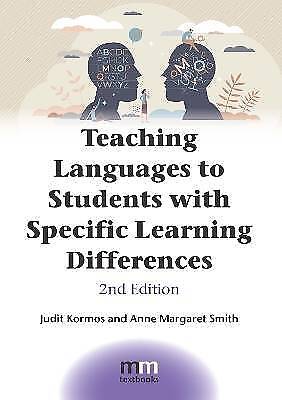- Home
- Various Articles (IP&SEN SIG) Inclusive Practices and Special Educational Needs SIG (IP&SEN SIG)
- Teaching Languages to Students with Specific Learning Differences 2nd edition by Judit Kormos and Anne Margaret Smith
Teaching Languages to Students with Specific Learning Differences 2nd edition by Judit Kormos and Anne Margaret Smith

Wanting to revise my basics and learn more about Specific Learning Differences I settled down to reread Kormos and Smith’s classic Teaching Languages to Students with Specific Learning Differences which was first published in 2012, when I realized that a second edition has just come out (Multilingual Matters 2024).
This edition, over eleven years after the first (doesn’t time fly?) contains much of the essential information of the first edition, while adding sections to cover recent research, and more importantly the addition of an inclusive outlook in many of the chapters such as the addition of a new chapter on Inclusive language teaching, which reflects a more up-to-date view on how to accommodate neurodiverse students in the language classroom. Chapter 1, now entitled Discourses of Disability in education, runs through the various types of discourse; medical, legal social, and inclusive. Rather than concentrate on dyslexia, chapter 2 summarizes a variety of different SpLDs including autism, and ADHD and presents a variety of hypotheses on the cognitive and neurological explanations behind these differences, including phonological deficit, difficulty automizing skills in general and speech rhythm deficit.
Chapter 3 resumes the possible impact of SpLDs in language teaching and chapter 4 discusses identification; that is to say spotting and assessing SpLD in students, and disclosure; how to share these findings with the student concerned. Chapter 5, entitled “Inclusive language teaching” reflects the advance towards a more equal accommodation for all students rather than previous adaptations such as differentiation; the idea of providing different work schemes based on different students needs. This chapter also includes a useful section concerning the online classroom, reflecting today’s reality of virtual language learning environments. Chapter 6 includes practical tips on various teaching methods, such as how to teach vocabulary, or grammar, or different skills, and the final two chapters are concerned with assessment and transitions between different learning environments.
Overall, the book provides a good balance of research, informing the reader of various theories on this field, while at the same time providing basic information on what to look out for and practical tips on making one’s classroom more inclusive. While some of the sections, such as how we learn how to read may seem very detailed for some of the readers, they are well explained and contain a huge amount of information that will help everyone working in language teaching to improve their knowledge in this area.
Each chapter ends with a summary of key points, various activities to encourage reflection on one’s own situation or how to apply the ideas presented in a specific context. The further reading section for each chapter enables those who are interested in going further, be it in theoretical research or in more practical works, such as “tips and strategies for exam success”. This book is a “must” for any language teacher, providing the necessary background knowledge as well as plenty of ideas on making one’s language classroom an inclusive and welcoming place for all learners.
Please check the Pilgrims f2f courses at Pilgrims website.
Please check the Pilgrims online courses at Pilgrims website.
Bilingual Education and Mathematics in Early Years and Inclusion
Athena Dermentzi, GreecePicture Books About Emotions in Kindergarten Language Classrooms
Agnieszka Dzieciol-Pedich, PolandChain Experiment in Pre-school
Dorota Kaniak-Szymkiewicz, PolandInterviewing Edoardo on LGBTQ Themes in Schools
conducted by Giovanni Licata, ItalyVolunteering with Ukrainian Refugees
Sinem Daridere, TurkiyeStories from the Hands Up Project
Jamie Keddie, SpainTowards Inclusive Learning Environments in Higher Education: A Glance into Perspectives from Education and Language Studies
Yasemin Yelbay Yilmaz, Turkiye‘Savouring’ Learning at Later Ages
Aysen Cem-Deger, TurkiyeTeaching Languages to Students with Specific Learning Differences 2nd edition by Judit Kormos and Anne Margaret Smith
reviewed by Rachael Harris, UK/FranceIntroducing Inclusive Practices and Special Educational Needs to Pre-service Teachers
Hanna Kryszewska, Poland